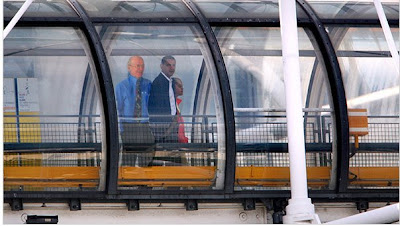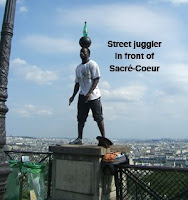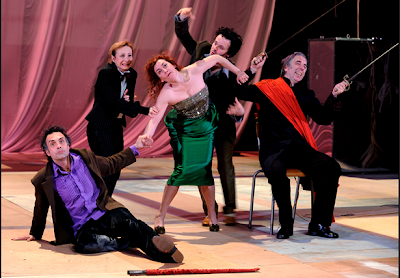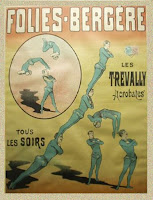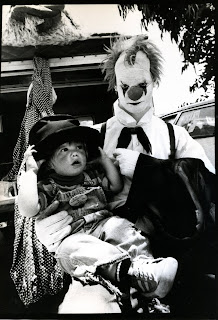 [post 008]
[post 008]
Installment #1
19th-Century Pantomime meets
21st-Century CGI
I thought it would be cute to begin a series entitled "On the Shoulders of Giants" by talking literally about standing on shoulders, what is commonly referred to as the "2-high." Pile on more bodies, perhaps flying off a teeterboard, and you get a 3-high, a 4-high, etc., but I sure am the wrong person to ask about this. I was pretty good at your basic 2-high, but that was it. I can still see Fred Garbo, somersaulting at me off a teeterboard some thirty years ago in a Gregory Fedin – Nina Krasavina circus class in Hoboken, NJ. Garbo was wearing a mechanic, maybe even coming in at reduced speed, probably weighed all of 135 pounds, but all I wanted to do was duck. I think he landed on my shoulders once or twice, and I managed to grab him, sortakinda, but I doubt I actually saw much of this.
Update: See
post 013 for some fantabuloso partner acrobatics from 1902-03 by the Julians Acrobats, with a lot of two-high variations.
The proper technique for the 2-high has been laid out quite thoroughly in
Circus Techniques (pp. 68-72) by
Hovey Burgess. [Full disclosure: I was an editor on this book, and Hovey was my first
understander back in my NYU days, back when the Delaware Indians still ruled Manhattan.]
And yes, the 2-high is indeed executed by performers known as the
understander and the
topmounter.
Karen Gersch, a skilled understander herself who once bravely had me on her shoulders as the
middleman in a 3-high, remarked that
understander was one of her favorite words in the English language because of its double meaning. Likewise, Corky Plunkett, father and understander in a family acrobatic troupe that was featured in a couple of circuses I was in, liked to say that "in acrobatics, you put the brains on the bottom of the pile." This may not be what Shakespeare had in mind when he penned this bit of repartee for
Two Gentlemen of Verona, but I've always liked to pretend it was:

SPEED: Why, then, how stands the matter with them?
LAUNCE: Marry, thus: when it stands well with him, it
stands well with her.
SPEED: What an ass art thou! I understand thee not.
LAUNCE: What a block art thou, that thou canst not! My
staff understands me.
SPEED: What thou sayest?
LAUNCE: Ay, and what I do too: look thee, I'll but lean,
and my staff understands me.
SPEED: It stands under thee, indeed.
LAUNCE: Why, stand-under and under-stand is all one.
___________________
So let's see where the laughs might come from with a 2- or 3-high — or for that matter a 31-high. I see two kinds of possibilities, because it seems to me that it might be useful to divide physical comedy into two categories. Now don’t you go frettin’ that I’m getting all intellectual on you here. Hey, I made it through grad school without understanding semiotics (though I did teach it once). But there are two types, and yes, this will be on the exam. (TOTAL DIGRESSION: one of my favorite quotes is “The world is divided into two kinds of people: those who believe the world is divided into two kinds of people, and those who don’t.”)
Did I mention there are two types of physical comedy? One is
presentational, and in this case would take the form of
comedy acrobatics, though of course there's also comedy juggling, comedy magic, etc.. The performers present (attempt) an act of skill in the here and now, but get laughs along the way, usually through a series of mishaps that are eventually overcome. The other approach uses physical comedy within a
storytelling structure, featuring characters in a real-life situation. The characters and the situation are often exaggerated, but there is a narrative that does
not take place in the here and now. Just think of your typical silent film comedy. As you will find, I am a big fan of both (you want me in your audience) but my deepest interest lies in the use of physical comedy within a narrative framework. What can I say? I like stories, I like content and context, and I like what physical comedy can say about the life we live. You don't have to share this bias... just letting you know.
Comedy Acrobatics & the 2-High
Most of the comedy acrobatics I've seen centering around the 2-high involves the topmounter's clumsiness in getting up there, slipping and falling on the way, and causing the understander to grimace pretty much non-stop. If the topmounter is female and wearing a dress, she might even falter and end up with the understander's head under her dress. It's been known to happen. In public.
I don't have the perfect comedy acrobatic clip for you, but here are a few brief seconds of such clumsiness from a routine by two unnamed acrobats on the old
Colgate Comedy Hour. [Anyone know who they are?] Notice the foot on the face.
In
The Playhouse, Buster Keaton's spoof of Vaudeville, a Zouave acrobatic act has to be replaced at the last moment by some ditch diggers from down the block, with the inevitable clumsiness.
The "broken column" dismount from the 2- or 3-high, as seen in this drawing from Georges Strehly's 1903 classic,
L'Acrobatie et les Acrobates, also usually gets a laugh. I'm guessing the laughter comes from the relief of tension, but you might have to ask Freud to be sure. The whole column tilts forward, staying in a straight line until the last split-second, when they all bail out

into some variation of a forward roll. This can be done with two people but is much more visually arresting with three. I even saw three Taiwanese women acrobats go directly from a 3-high into a 3-person peanut roll and then roll backwards right back up into a 3-high.
Wow! indeed.
[Note: a peanut roll is what the "Colgate" acrobats do at the end of that video above.]
Just to prove I can still translate French, this is what Strehly wrote about it:
One of the most original and unexpected moves is the broken column. The performers, balanced in a 3-high, let themselves fall forward and, at the moment when they are about to hit the ground, detach themselves from one another and complete the fall with a saut de nuque.
And what exactly is a
saut de nuque? Translated literally it's a neck dive, and is explained by Strehly as follows:
The saut de nuque, uniquely reserved for clowns, at first resembles the saut de lion, but instead of having the arms in front of the body, they are left glued to the body and, at the moment when it seems that the head is about to smash into the ground, the chin is brought to the chest so that it is the neck or, to be more precise, the muscles in the cervical region that break the fall.
Here's a video clip of the acrobatic team Quatour Stomp doing a broken column from a 2-high, atop a table no less, though with a fairly early break and with a conventional forward roll.
And Strehly adds a variation I'd never heard of:
One increases the difficulty, but not the effect, of this cascade by falling backwards. At the moment when it seems that the three performers are about to land flat on their backs, they disengage from one another, execute a half-pirouette, place their hands en parade, and complete the movement with a saut de nuque.
I don't know, I've never seen this done, but I'm betting it would increase the effect for me big time. [And no, I'm not positive what
en parade means, though I could guess. Neither
Harrap's nor the internet are any help, but I'd be happy to hear from any of the 90 million francophones out there, most of whom I assume read this blog.]
 Update
Update:
a poster of the
Trevally Acrobats (1907-8):
Storytelling
If you're telling a story and one character is standing on another's shoulders, there's got to be a reason. You can't just stand there and shout "Ta-Da!" Maybe you're trying to reach somewhere you shouldn't be. If so, you might need to make a quick escape. The classic example of this is from Buster Keaton's
1920 silent short,
Neighbors. Keaton is in love with the girl next door but can't marry her because the families are arch enemies, so elopement is the only answer. Unlike
Romeo and Juliet, this one has a happy ending thanks to some, er, understanding friends.
Even given that the bride-to-be topmounter is replaced by a dummy in most of the shots, the dexterity with which the three-high disassembles and reunites to make its way through the neighborhood obstacle course is amazing and transforms what is usually a static stunt into a refreshingly original chase scene. Skill, story, and comedy merge perfectly.
Keaton was an incredibly creative comedian and filmmaker, so it would not be surprising for him to have concocted all this on his own, but he was also a Vaudeville veteran who had not only performed with his family's knockabout troupe since the age of three, but had no doubt worked on the same bill with hundreds of other physical performers along the way. So I was not all that surprised to come across this poster of the Byrne Brothers'
Eight Bells while doing research for my
Clowns book.
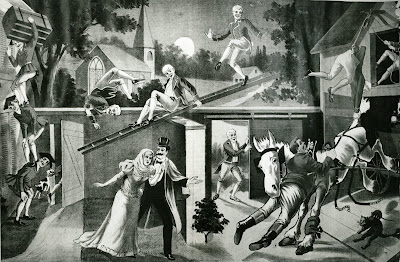
Notice the sneaky three-high off to the left, carrying off a trunk, not to mention the ladder pivoting on the fence, which also is a major physical gag in
Neighbors.
Eight Bells was performed by the Byrne Brothers from 1890 to 1914, when it was replaced by a similar piece,
An Aerial Honeymoon. Keaton had begun performing in Vaudeville
before the turn of the century, so I'd say the similarities are hardly coincidental.
Human Pyramids in a CGI World
Fast forward to the 21st century (
aka, now), where big budgets and CGI (computer-generated imagery) have resulted in some amazing television commercials that mine the physical comedy tradition to hawk such essentials as $100 sneakers and watered-down beer. But give credit where credit is due: some of these spots are highly creative and quite funny, though little or no physical skill may be involved. Here's Kevin Garnett, in real life an immensely talented basketball player, in the Adidas "Carry" ad, backed up by Etta James singing "He's Got the Whole World in His Hands." The visual effects are by
Method Studios (Santa Monica, Ca.).
And you thought I was joking about a 31-high! [Okay, 31 is an approximation, but you get the idea.]
Viewed as physical comedy, this commercial raises two obvious questions: is it physical and is it comedy?
You are of course right in assuming that Kevin Garnett did not walk around town with all those people on his back. Instead, he wore a rig that was used to collect position data for motion tracking so that performers hanging from a rig in a green screen studio could be composited into the shot. You can get a more thorough explanation from artist
Andrew Bell, but meanwhile here are some pics showing how Street Shot w/ Rig + Greenscreen Shot = Final Composite:


There's some physical work here — the guy diving off the building is probably a stunt man — but otherwise it's pretty much an illusion. If this gets your dander up about truth and live vs. digital performance, I'm glad because I have every intention of fomenting controversy on this issue in later posts! Still, because this pyramid is such an obvious exaggeration, it doesn't bother me as much as other faked physicality. It's all done with a wink. And the joke itself isn't bad, the gag of repetition leading to the "impossible" pyramid, nicely contrasting with the nonchalance of Garnett. I admit to liking it.
Here's another video snippet of a wild human pyramid (this one dances!). I don't even know what this is from, but you'll find it on the Method Studios
demo reel.
Okay, a 31-high is fine and all, but the Miller Lite "Break from the Crowd" commercial creates a 1200-body human pyramid that is a rampaging monster of conformity. (And you thought I was kidding about a 1200-high!) So what if 99.9% of the bodies aren't real?
Yep, that was also done by Method Studios under the direction of Alex Frisch; they seem to have a thing about pyramids. Effects like these are accomplished with specialized crowd-creation AI software such as
Massive.
Here are some pics showing how they put together the shot at the end that combines these CGI bodies with a few real humans.





For those of you out there with a serious interest in visual effects, you can learn more about how this was done from an interview with Frisch at
fxguideTV: there's a
high-bandwidth version and a
low-bandwidth version. The discussion of this commercial starts at the 3–minute mark.
It looks like even less actual physicality went into the making of this one, but the visual idea of the monster pyramid representing the conformity of the crowd is a striking one, and our hero's escape from it funny enough. Too bad it wasn't for a better brand of beer.
Human Pyramids: Sacred Cultural Tradition?
Widen the base of your three-high and you can add a lot more bodies, creating what's called a
human pyramid because of its inverted-V shape. We all did these in high school — you can probably still feel those knees in your shoulder blades — and
YouTube is full of such stunts. They are supposed to teach teamwork, and with all those understanders there should be one huge heap of understanding.
In Catalonia (Spain), this is carried several steps further — oops, I mean higher — by the
castell folk tradition dating back several centuries. "Castle-building" competitions pit large teams (650 members, all living, breathing sentient beings) against one another. One pyramid goes ten stories high and, according to this video, has a base of 400. Talk about community building!
And Now It's Silly Time:
A Three-High in Outer Space
Eat your heart out, earthbound Catalans! This brief segment from Howard Smith's odd documentary film
Gizmo shows astronauts on the Skylab space station taking advantage of weightlessness to do a three high at the very beginning of the clip and, later on, a triple-decker, no-hands push-up.
__________________________________
As Sir Isaac Newton once said, "Th, th, that's all folks." Comments and additions welcome!
 [post 019]
[post 019]



